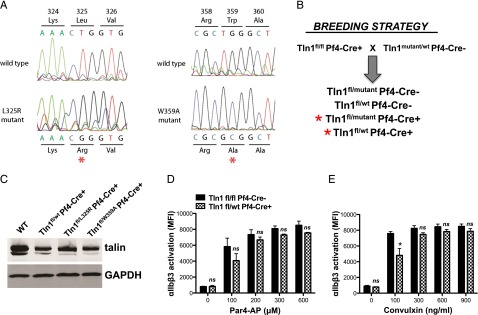Figure 1.

Generation of mice expressing talin1 mutants in platelets. (A) Sequencing chromatograms of mutated regions of Tln1(L325R) and Tln1(W359A) ES cells. Genomic DNA isolated from targeted ES cells was used as a template for polymerase chain reaction (PCR) using primers that amplified the mutated sequences, and PCR amplicons were sequenced. (B) Mouse breeding strategy to obtain mice with Tln1(L325R) and Tln1(W359A) expressing platelets. (C) Western blot analysis showing similar levels of talin expression in control (Tln1wt/flCre+) and mutant (Tln1L325R/flCre+ and Tln1W359A/flCre+) platelets. Par4-AP (D) or convulxin-induced (E) αIIbβ3-integrin activation (JON/A-PE binding). Reduced levels of talin1 protein in Tln1WT/fl Cre+ platelets had minimal effect relative to Tln1fl/fl Cre– platelets. Bar graphs represent MFI ± SEM (n = 6, 3 independent experiments). *P < .05.
